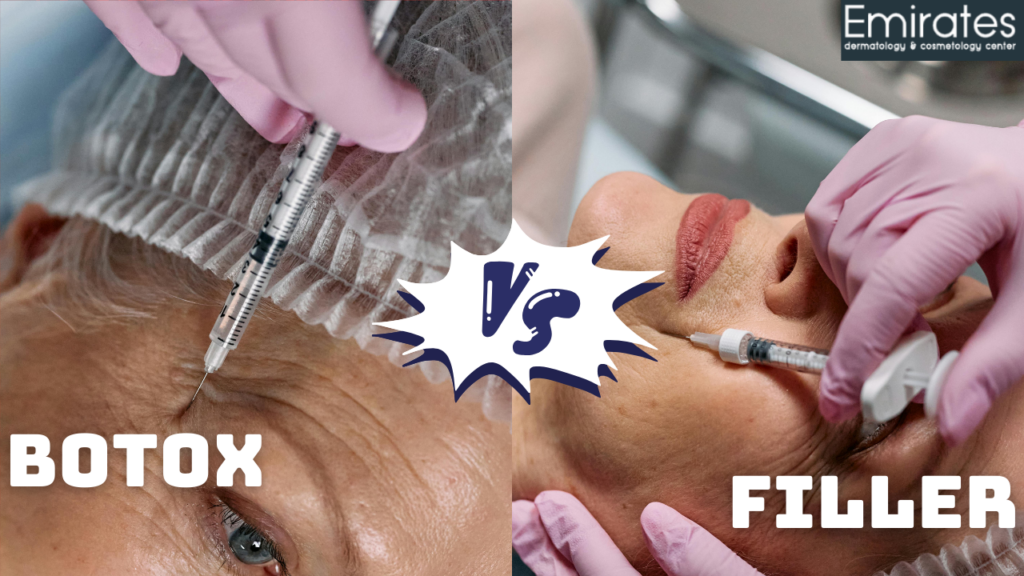Filler vs Botox: How to Choose the Right One for You
Botox and fillers are two of the most popular non-surgical, non-invasive cosmetic procedures to look out for if you’re thinking of removing wrinkles and other skin enhancements. While the end goal is the same, what makes your journey different depending on the procedure you choose? And most importantly, how do you know which procedure would work best for you? We’ll address these questions here and here’s a comprehensive guide on Botox vs fillers, as you require a proper understanding of both procedures to determine what works best for you. What is the difference between Botox and dermal fillers? Botox uses injections of Botulinum toxin to freeze your muscles around the injection site to soften and remove wrinkles. Dermal fillers use injections of hyaluronic acid-based fillers to add volume to the treated areas. While the idea of result is the same, the procedures are fundamentally different from each other. Except for the fact that both procedures involve injection, everything varies from the substance used, number of sessions, duration, and aftercare. But let’s not get ahead of ourselves. Let’s examine each procedure one by one, understand how they work, and do some comparisons on various aspects. What is Botox? Botox, also known as onabotulinumtoxinA, is a specially designed compound used to temporarily improve the skin, especially effective on wrinkles. Botox is the name of the trademarked brand that developed this formula. Going a bit deep into the technical side, a report by the National Library of Medicine, each vial of Botox® contains 100 Units (U) of Clostridium botulinum type A neurotoxin complex, 0.5 milligrams of Albumin (Human), and 0.9 milligrams of sodium chloride in a sterile, vacuum-dried form without a preservative. How Does Botox Work? Wrinkles and lines are formed when there are excessive muscle movements surrounding the skin. The idea of Botox is to make these movements more relaxed. And that’s where it’s ingredients come in. The main ingredient Clostridium botulinum type A is a bacteria that produces botulinum toxin, which is responsible for the desired results. It’s a neurotoxic protein upon use in very small concentration, cuts the connection between muscles in the injected area and the nerves connecting them. This helps the muscles to be relaxed and consequently it softens the muscle movement. No excessive moments, no wrinkles! Does Botox Work for Everyone? Botox is a popular non-invasive procedure that has proved effective for many, including celebrities like Cindy Crawford who have been vocal about Botox in multiple interviews. But like every other procedure, the results you get depends on you. For first-time users, the effects might not last as long. This is because the muscles are still strong and accustomed to frequent movement. However, with consistent treatments, many people find that their results start lasting longer because the muscles become trained to stay relaxed. Some people develop a natural immunity against the botulinum toxin and this makes Botox less effective for them. Areas with more muscle activity, such as the forehead, might see Botox wear off faster than less active areas. Then comes the way you do aftercare. If you don’t take care of your skin after the procedure, the effectiveness is in question. And most importantly, the success depends on the expertise of your Botox treatment provider, who must be equipped to strategically place Botox to maximize longevity and maintain a natural look. What Do Fillers Do? Now that you’ve got a picture of what is a Botox treatment, let’s move on to fillers. Like Botox, filler treatment also involves a non-invasive injection. But instead of neurotoxins, fillers are used. FIllers constitute hyaluronic acid (HA) or calcium hydroxylapatite that give volume and definition to the site of injection. fillers can plump lips, add cheek volume, and soften deep lines around the mouth. Botox vs Fillers: Key Differences The first and most obvious difference is the substance used for injection and the way they work. While Botox effectively freezes your muscles making them less susceptible to excessive movements and this in turn removes wrinkles and lines. Fillers on the other hand plumps up the area making your face look more youthful. But let’s differentiate Botox and fillers on different aspects. Target Areas Botox is best for dynamic wrinkles caused by muscle movement, such as forehead lines, crow’s feet, and frown lines. Fillers are more suitable for static wrinkles and volume loss and are commonly used for plumping lips, contouring cheeks, and filling nasolabial folds. Results and Longevity We’ve touched upon this before. Be it Botox or face fillers, the results and longevity depends on your skin, your metabolism, and how you do aftercare. Fillers generally last longer than Botox but the results obtained from Botox are more evident and obvious. How long does Botox last? Botox typically lasts 3-6 months after which the effects start to fade. But it depends on several factors. The most important one would be your metabolism, skin type and muscle strength. People with strong, thick facial muscles may require a higher dosage of Botox to see the same effect as someone with naturally weaker muscles. Some people’s metabolism causes breakdown of Botox faster than others, leading to shorter-lasting effects. You can attribute this to age, levels of physical activity, and overall metabolism speed. How long do fillers stay in your face? On average, you can see most dermal fillers lasting between six months and two years. Popular brands of fillers Juvederm and Restylane assure at least one year of longevity. Fillers unfortunately fall short to fast metabolism but you can do interim sessions just to amplify its effect. In terms of frequency, fillers are a better option than Botox. Onset of Results One of the biggest differences between Botox and fillers is how quickly you see results. If you’re considering these treatments, it’s essential to understand what to expect after your appointment so you can plan accordingly. How long does Botox take to work? While the procedure usually doesn’t take more than an hour, the working of the botox compounds inside your
Filler vs Botox: How to Choose the Right One for You Read More »


